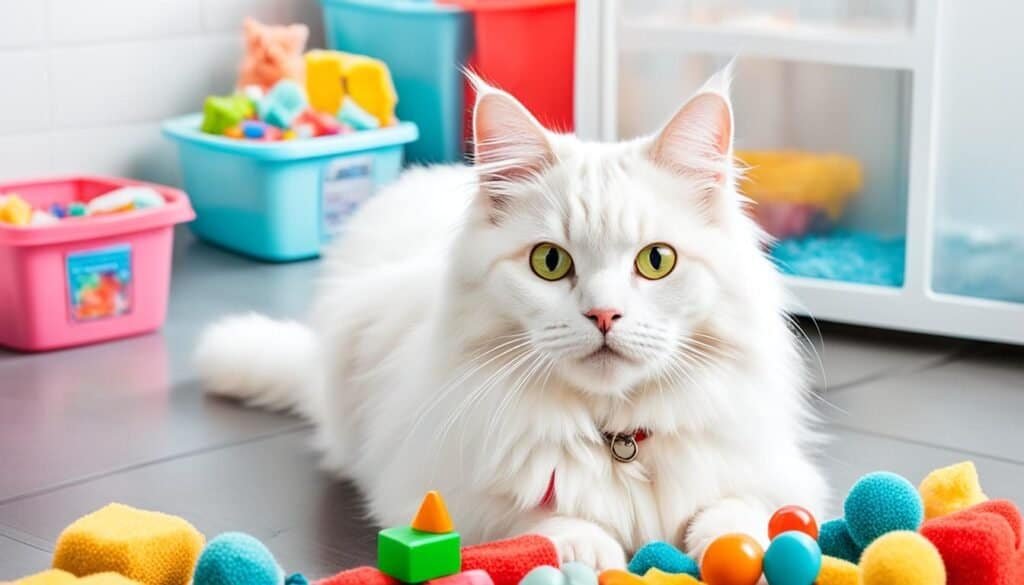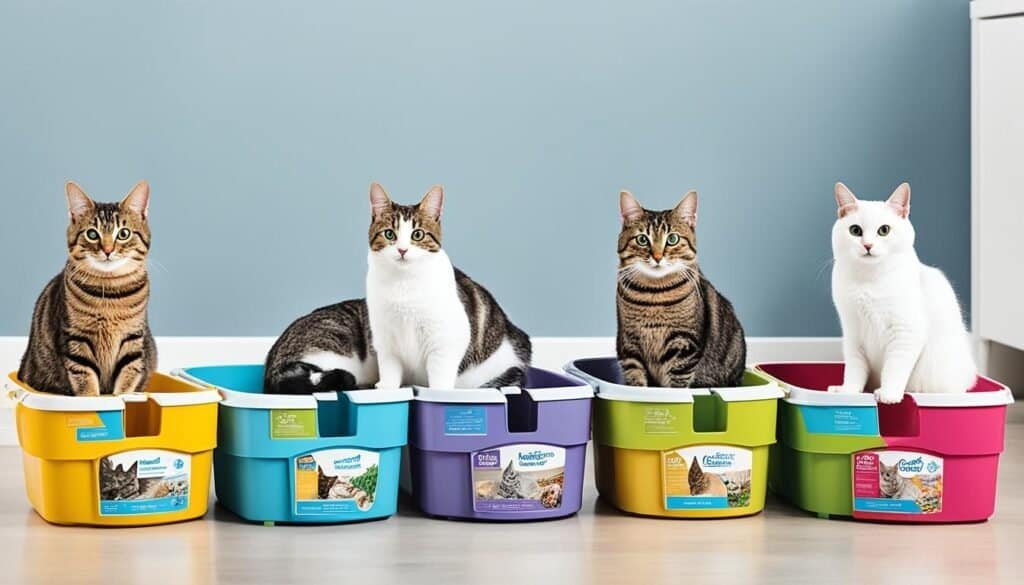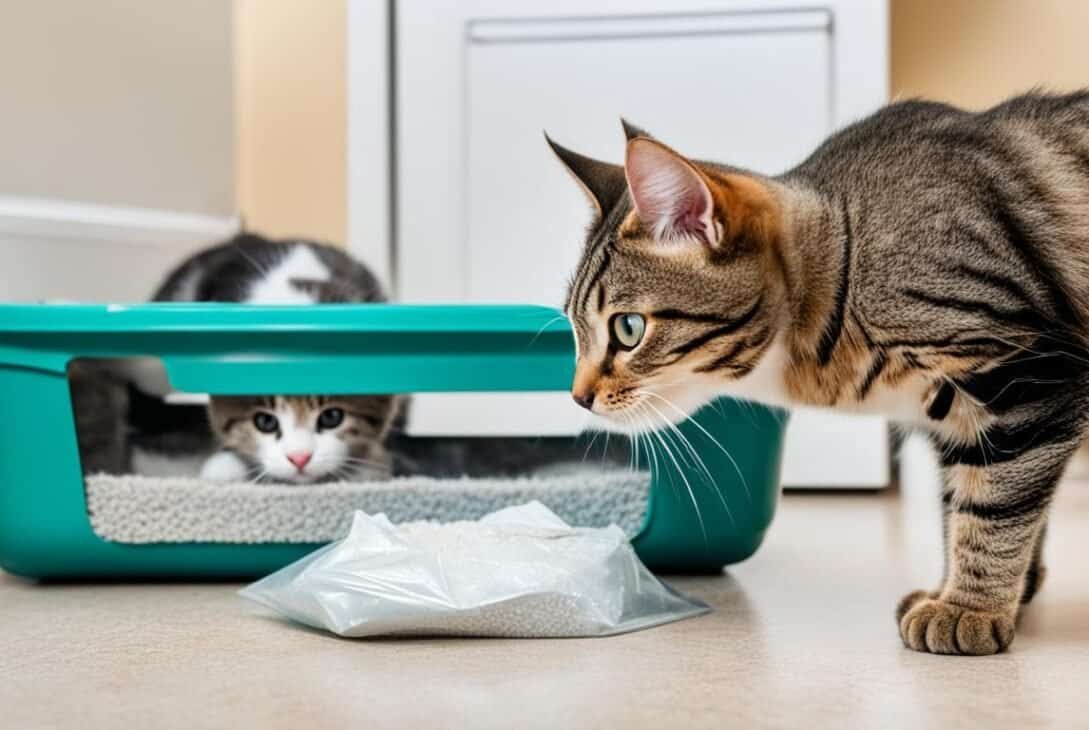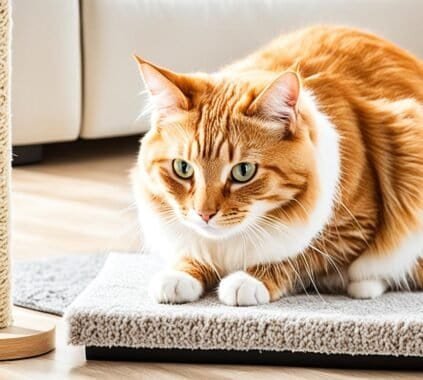Welcome to our comprehensive guide on cat litter box training! If you’re a cat owner, you understand the importance of teaching cats to use the litter box properly. Not only does it ensure a clean and hygienic living environment, but it also promotes your cat’s health and well-being. In this section, we will explore the significance of litter box training and provide valuable insights on how to successfully train your cat.
Key Takeaways:
- Litter box training is crucial for maintaining a clean and hygienic living environment for your cat.
- Training your cat to use the litter box reduces the risk of indoor accidents and promotes good litter box habits.
- Understanding your cat’s natural instincts and behaviors is essential for successful litter box training.
- The choice of litter box and litter type greatly impacts your cat’s willingness to use the litter box consistently.
- Introducing the litter box properly and encouraging your cat to use it is key to successful training.
Understanding Your Cat’s Natural Instincts
Before you begin cat potty training, it’s crucial to have a solid understanding of your cat’s natural instincts and behaviors when it comes to using the litter box. By familiarizing yourself with these innate tendencies, you can tailor your training approach to best suit your feline friend’s needs.
Cats are naturally clean animals. They have an instinctual desire to bury their waste to hide their presence from potential predators. Understanding this instinct is vital, as it forms the foundation of successful litter box training.
Provide a suitable litter box. Cats are generally selective about where they eliminate, preferring clean, private spaces. Ensure the litter box is large enough for your cat to move comfortably and that it offers easy access.
Consider your cat’s preferences. Some cats have specific preferences when it comes to litter box placement, such as privacy or proximity to food and water. Observing and accommodating these preferences can help increase the likelihood of successful training.
Monitor your cat’s behavior. Pay attention to your cat’s body language and behavior while using the litter box. This can provide valuable insights into their preferences and any potential issues that may need to be addressed, such as signs of discomfort or avoidance.
Introduce positive reinforcement. Cats respond well to positive reinforcement during training. Use treats, praise, and affection to reward your cat when they use the litter box correctly. This helps reinforce the desired behavior and creates a positive association with the litter box.
To further enhance your understanding of your cat’s natural instincts and behaviors, consult with a veterinarian or professional animal behaviorist who can provide expert guidance tailored to your cat’s specific needs.
Choosing the Right Litter Box
When it comes to litter box training, one of the key factors for success is choosing the right litter box for your cat. The type of litter box you select can greatly influence your cat’s comfort and willingness to use it consistently. In this section, we will explore the different types of litter boxes available and provide valuable tips to help you make the best choice.
Types of Litter Boxes
There are various types of litter boxes on the market, each with its own advantages and considerations. Here are a few popular options to consider:
- Traditional Open-Top Litter Box: This is the most common type of litter box available. It provides easy access for your cat and is suitable for cats of all ages and sizes. However, if your cat tends to scoop litter out of the box or you’re concerned about odors, you may want to consider other options.
- Covered or Hooded Litter Box: This type of litter box comes with a removable cover or hood that provides privacy for your cat and helps contain odors. Some cats prefer the added privacy, while others may feel trapped. Monitor your cat’s behavior to determine if this type suits their needs.
- Top-Entry Litter Box: This innovative design features a top entrance, which helps keep litter inside the box and prevents tracking around the house. It’s an excellent option for cats that tend to kick litter out of open-top boxes or for households with dogs who might be tempted to investigate the litter box.
Remember, every cat has unique preferences, so it may take some experimentation to find the litter box that your cat feels most comfortable with. Monitor their behavior and adjust as needed.
Tips for Selecting the Most Suitable Litter Box
When choosing a litter box, keep the following tips in mind:
- Size Matters: Ensure the litter box is large enough for your cat to comfortably move around and dig in. Cats appreciate having ample space to do their business without feeling cramped.
- Easy Access: Opt for a litter box with low sides or a cutout entrance to make it easy for your cat to enter and exit. This is especially important for kittens, older cats, or those with mobility issues.
- Odor Control: Look for litter boxes with built-in odor control features, such as carbon filters or covered designs, to help keep your home smelling fresh.
- Easy Maintenance: Consider the ease of cleaning and maintaining the litter box. Choose a litter box with smooth surfaces and removable parts for hassle-free cleaning.
By selecting the right litter box, you can create a positive and inviting environment for your cat to begin their litter box training journey.
Selecting the Right Litter
When it comes to successfully training your cat to use the litter box, selecting the right litter is essential. The type of litter you choose can greatly impact your cat’s willingness to use the litter box consistently, so it’s important to make an informed decision.
There are several different litter options available, each with its own pros and cons. Let’s explore some of the best cat litter box training techniques:
1. Clumping Cat Litter
Brands like Tidy Cats and Arm & Hammer offer excellent clumping cat litter options.
This type of litter forms solid clumps when it comes into contact with moisture, making it easy to scoop out and keep the litter box clean. Clumping cat litter is generally preferred by cat owners due to its convenience and odor control properties. It provides a comfortable and familiar texture that most cats find appealing.
2. Natural or Biodegradable Cat Litter
Brands like World’s Best Cat Litter and ökocat offer natural or biodegradable cat litter options.
Natural or biodegradable cat litter is made from renewable materials such as corn, wheat, or wood pellets. It offers a more eco-friendly alternative to traditional clay-based litters. This type of litter is generally dust-free and provides good odor control. However, it may take some time for cats to adjust to the different texture and scent.
3. Silica Gel Crystals
Brands like Fresh Step and PrettyLitter offer silica gel crystal cat litter options.
Silica gel crystal cat litter consists of small, absorbent crystals that trap and eliminate moisture and odor. It’s known for its exceptional absorbency and long-lasting effectiveness. Silica gel crystal litter is typically low-dust and hypoallergenic, making it a great option for cats with allergies or sensitivities.
When selecting the right litter for your cat, consider their preferences, any specific needs or sensitivities they may have, and the overall effectiveness of the litter. It’s also important to gradually transition your cat to a new litter to avoid any aversions or litter box issues.
By choosing the most suitable litter for your cat’s comfort, you’ll increase the chances of successful litter box training and ensure a happy and content feline friend.
Introducing the Litter Box
Properly introducing the litter box to your cat is crucial for successful training. Whether you have a new kitten or an adult cat, the process remains the same. By following these step-by-step instructions, you can ensure a smooth transition and encourage your feline friend to use the litter box consistently.
1. Choose the right location
Find a quiet and easily accessible spot in your home to place the litter box. Make sure it offers some privacy for your cat while still being easily accessible. Avoid placing it near your cat’s food and water bowls.
2. Set up the litter box
Open the litter box and remove any packaging or tags. Fill it with a couple of inches of your chosen litter. Remember, some cats may have preferences for certain litter types, so consider their comfort.
3. Show your cat the litter box
Gently bring your cat or kitten to the litter box and place them inside. Allow them to explore the box at their own pace. Some cats may start using it immediately, while others might take some time to get acquainted with it.
4. Encourage sniffing and digging
While your cat is inside the litter box, gently take their front paws and simulate scratching or digging motions in the litter. This action helps trigger their natural instinct to relieve themselves in a sandy substrate.
5. Praise and reward
When your cat shows interest in the litter box or attempts to dig, offer verbal praise and gentle petting. Positive reinforcement helps associate the litter box with a positive experience and encourages further use.
6. Repeat and create a routine
Continue placing your cat in the litter box after meal times, nap times, and around predictable bathroom times. If accidents occur outside the litter box, gently move your cat to the box to reinforce proper behavior.
Remember, each cat is unique, and the time it takes for them to adjust to the litter box may vary. Patience and consistency are key to successful litter box training.
Encouraging Your Cat to Use the Litter Box
Now that you have introduced the litter box to your cat, it’s time to encourage them to use it consistently. Establishing a routine for bathroom habits is essential for successful cat potty training. Here are some effective techniques to motivate your cat:
- Create a comfortable environment: Ensure that the litter box is placed in a quiet, private area where your cat feels safe and secure. Cats prefer a peaceful environment when using the litter box.
- Positive reinforcement: Reward your cat with praise or treats whenever they use the litter box. Positive reinforcement helps reinforce the behavior you want from your cat.
- Show, don’t tell: Gently place your cat in the litter box after meals or naps to encourage them to associate the litter box with bathroom time. Be patient and give them time to explore and familiarize themselves with the litter box.
- Regular cleaning: Cats are often fastidious creatures and prefer a clean litter box. Scoop the litter box daily and change the litter frequently to maintain cleanliness. This will encourage your cat to use the litter box consistently.
- Litter preferences: Experiment with different types of litter to find the one that your cat prefers. Cats have unique preferences when it comes to litter texture and scent. Offering options will encourage your cat to use the litter box willingly.
Remember, consistency is key when it comes to cat litter box training. Be patient with your cat and provide them with a positive and encouraging environment. With time and proper guidance, your cat will soon become comfortable using the litter box on a regular basis.
Troubleshooting Common Issues
While litter box training for cats is generally straightforward, some cats may encounter issues during the process. It’s essential to address these common problems to ensure successful indoor cat litter box training.
Litter Box Aversion
Litter box aversion is a common issue that can arise during training. Cats may avoid using the litter box for various reasons, such as discomfort, dislike for the litter, or association of the box with a negative experience. To overcome litter box aversion:
- Ensure the litter box is clean and odor-free, scooping it daily and changing the litter regularly.
- Experiment with different litter options to find one that your cat prefers.
- Provide multiple litter boxes in different areas of the house to increase accessibility.
- Make sure the litter box is in a quiet and private location.
Inappropriate Elimination
Inappropriate elimination refers to cats urinating or defecating outside the litter box. This behavior can be frustrating, but there are steps you can take to address it:
- Clean any areas where your cat has eliminated outside the litter box thoroughly to remove any lingering odor.
- Identify potential triggers or stressors that may be causing the behavior and address them accordingly.
- Consult with a veterinarian to rule out any underlying medical conditions that could be contributing to the behavior.
- Consider using pheromone diffusers or sprays to create a calming environment for your cat.
By troubleshooting these common issues, you can help your cat overcome any hurdles during the litter box training process and ensure a successful transition to using the indoor litter box.

Maintaining a Clean Litter Box
Keeping your cat’s litter box clean and odor-free is essential for their comfort and hygiene. Regular maintenance and cleaning routines not only ensure a pleasant litter box experience for your feline friend but also promote a healthy environment for both of you. Here are some cat litter box tips to help you maintain cleanliness:
1. Scoop the litter box daily
Remove solid waste and clumps of urine-soaked litter from the litter box using a scooper. Doing this daily helps prevent the buildup of odor and keeps the litter box clean and inviting for your cat. Disposable litter box liners can make scooping easier and minimize mess.
2. Deep clean the litter box regularly
In addition to daily scooping, it’s important to deep clean the litter box periodically. Empty the litter, wash the box with mild soap and water, and dry it thoroughly before adding fresh litter. This helps eliminate any residual odors and bacteria that may accumulate over time.
3. Use an odor-neutralizing litter
Consider using a kitty litter box training litter that is specially formulated to neutralize odors. These litters can help control unpleasant smells and keep your home smelling fresh. Look for litters that are labeled as odor-neutralizing or have activated carbon or baking soda as ingredients.
4. Keep the litter box in a well-ventilated area
Proper ventilation is important to prevent the buildup of ammonia and other strong odors in the litter box area. Ensure that the litter box is placed in a well-ventilated area of your home, away from food and living spaces. This helps maintain a fresh and odor-free environment.
5. Consider a litter box with a hood
A litter box with a hood or cover can help contain odors and prevent litter scatter. The cover also provides privacy for your cat, making them feel more secure while using the litter box. Make sure to choose a hooded litter box that is spacious enough for your cat to move comfortably.
6. Replace the litter box regularly
Over time, even with proper cleaning, litter boxes can start to develop wear and tear, making them less hygienic. Consider replacing the litter box every year or as needed to ensure your cat always has a clean and fresh place to do their business.
By following these cat litter box tips, you can create a clean and inviting environment for your cat while maintaining a fresh-smelling home. Remember, regular maintenance and cleanliness are key to successful kitty litter box training and a happy cat.
Multiple Cat Household Training
If you have multiple cats, litter box training can be a bit more challenging. However, with the right strategies and some patience, you can successfully train all your cats to use the same litter box.
Here are some tips to help you navigate the training process:
- Provide multiple litter boxes: In a multiple cat household, it’s important to have enough litter boxes for each cat, plus one extra. This helps prevent overcrowding and ensures that each cat has easy access to a litter box when needed.
- Choose the right location: Place the litter boxes in quiet and accessible areas of your home. Cats prefer privacy when using the litter box, so avoid placing them in high-traffic areas or near their feeding stations.
- Use unscented litter: Some cats can be sensitive to strong scents, and using unscented litter can help prevent aversion or discomfort. Choose a litter that is safe for multiple cats and has good absorbency.
- Monitor the litter boxes: Regularly check and clean the litter boxes to ensure they are kept tidy and odor-free. Cats are more likely to use a clean litter box, so maintaining cleanliness is crucial in a multi-cat household.
- Address territorial issues: Cats can be territorial, and conflicts may arise when sharing a litter box. If you notice any signs of aggression or tension, consider providing separate litter boxes for each cat and gradually move them closer together over time.

By following these tips and being consistent with training, you can successfully train multiple cats to use the same litter box and promote harmony in your household.
Transitioning from Outdoor to Indoor Litter Box
If you’re transitioning your cat from outdoor to indoor living, teaching them to use a litter box is a crucial step in ensuring their comfort and maintaining a clean household environment. Outdoor cats may not be familiar with the concept of a litter box, so a patient and consistent approach is necessary to help them adjust.
To begin the transition, place the litter box in a quiet and easily accessible area of your home. Choose a litter that closely resembles the texture of the ground your cat is accustomed to outside. This can help make the transition more natural for them.
Encourage your cat to investigate the litter box by gently placing them inside it. Allow them to explore and dig around on their own. If they show signs of anxiety or reluctance, try placing some soil or leaves from their outdoor environment in the litter box to make it more familiar and appealing to them.
Consistency is key when teaching outdoor cats to use a litter box. Establish a routine for taking your cat to the litter box after meals and naps, as well as when they show signs of needing to relieve themselves. Reward them with praise and treats when they use the litter box successfully.
If your cat continues to have accidents, be patient and avoid scolding or punishing them. Instead, clean up any messes promptly and thoroughly to remove any lingering scent markers. Consider using an enzyme-based cleaner to eliminate odors completely.
Monitor your cat’s progress closely and provide extra support during the transition period. If they continue to struggle with using the litter box consistently, consult with a veterinarian to rule out any underlying health issues that may be affecting their litter box habits.
Remember, every cat is unique, and the transition from outdoor to indoor living may take time. Stay consistent, patient, and understanding throughout the process, and your cat will gradually adapt to using the litter box.
Addressing Medical Issues
In some cases, cats may develop medical issues that can affect their litter box habits. It’s essential to recognize potential health concerns early on and address them appropriately while continuing with the litter box training process. By understanding and addressing the medical issues that your cat may be experiencing, you can help ensure a successful training journey.
Here are some important considerations when it comes to addressing medical issues during indoor cat litter box training:
- Consult with a veterinarian: If you notice any sudden changes in your cat’s litter box behavior or suspect underlying health issues, it’s crucial to seek professional advice. A veterinarian can conduct a thorough examination and provide guidance on appropriate interventions.
- Rule out medical conditions: Cats may avoid using the litter box due to urinary tract infections, bladder stones, or other medical conditions. A veterinarian can perform diagnostic tests to identify any underlying health concerns and recommend appropriate treatment.
- Provide a comfortable litter box: Some medical issues, such as arthritis, can make it difficult for cats to access the litter box. Consider providing a litter box with low sides or a ramp to ensure ease of entry. Additionally, using a litter consisting of softer texture can be more comfortable for cats with sensitive paws.
- Offer multiple litter box options: Cats with medical issues may benefit from having access to multiple litter boxes throughout your home. This can decrease the chances of accidents if they are unable to reach a specific litter box due to mobility issues.
Remember, addressing medical issues is essential for your cat’s overall well-being. By working closely with a veterinarian and providing appropriate accommodations, you can help your cat successfully navigate the indoor cat litter box training process.
Conclusion
Cat litter box training is an essential aspect of pet ownership, ensuring both your cat’s well-being and the harmony within your household. By consistently training your cat to use the litter box, you can eliminate the stress and frustration that comes with accidents and inappropriate elimination.
Celebrate your cat’s success throughout the training process. Positive reinforcement, such as treats or praise, can go a long way in reinforcing the desired behavior. Remember, patience and consistency are key when it comes to cat litter box training.
Successful litter box training not only benefits your cat but also keeps your home clean and odor-free. It promotes a hygienic environment, safeguarding against potential health issues and maintaining a harmonious living space for both you and your feline companion. So, invest the time and effort in training your cat to use the litter box, and you’ll reap the rewards of a contented and well-trained pet.
FAQ
Why is cat litter box training important?
How do I understand my cat’s natural instincts for litter box training?
What factors should I consider when choosing a litter box?
What type of litter should I use for litter box training?
How do I introduce the litter box to my cat?
How do I encourage my cat to use the litter box consistently?
What should I do if my cat is not using the litter box?
How should I maintain a clean litter box?
What should I do if I have multiple cats in my household?
How do I transition my outdoor cat to using an indoor litter box?
What should I do if my cat shows changes in litter box habits due to a medical issue?
Last modified: March 12, 2024













